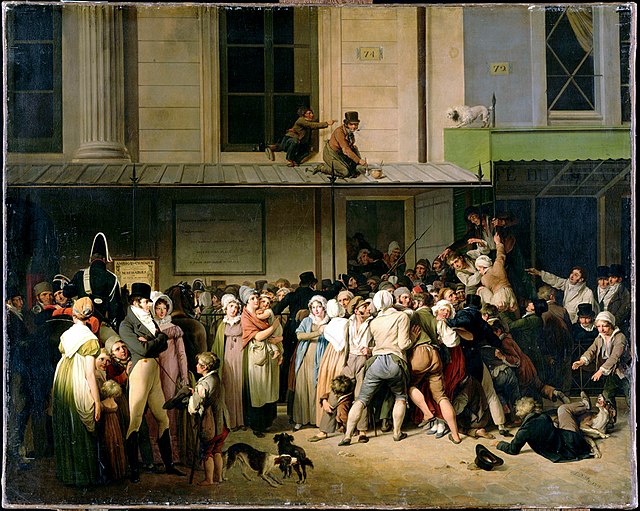Théâtre de l'Ambigu-Comique
The Théâtre de l’Ambigu-Comique, a former Parisian theatre, was founded in 1769 on the boulevard du Temple immediately adjacent to the Théâtre de Nicolet. It was rebuilt in 1770 and 1786, but in 1827 was destroyed by fire. A new, larger theatre with a capacity of 2,000 as compared to the earlier 1,250 was built nearby on the boulevard Saint-Martin at its intersection with the rue de Bondy and opened the following year. The theatre was eventually demolished in 1966.
The entrance to the Théâtre de l'Ambigu-Comique on the day of a free show. Louis-Léopold Boilly (1819)
The Théâtre de l'Ambigu-Comique on the boulevard Saint-Martin
Plans of the Ambigu-Comique (left) and the Théâtre de Nicolet (Théâtre de la Gaîté (boulevard du Temple), right), on the boulevard du Temple. The Ambigu-Comique and the Gaîté had a smaller number of boxes for privileged clientele than other Parisian theatres. These were separated by only half partitions that were more steeply angled toward the stage. The boxes usually found at the rear of a theatre were replaced with galleries of benches which seated more people. These arrangements provided more patrons with a better view of the stage, rather than a view of the other members of the audience.
Poster for an 1896 production at the Theâtre
The Boulevard du Temple, formerly nicknamed the "Boulevard du Crime", is a thoroughfare in Paris that separates the 3rd arrondissement from the 11th. It runs from the Place de la République to the Place Pasdeloup, and its name refers to the nearby Knights Templars' Temple, where they established their Paris priory.
Boulevard du Temple
The earliest photograph of the Boulevard du Temple is by Louis Daguerre (1838)
The theatres of the boulevard du Temple (ca. 1862)







